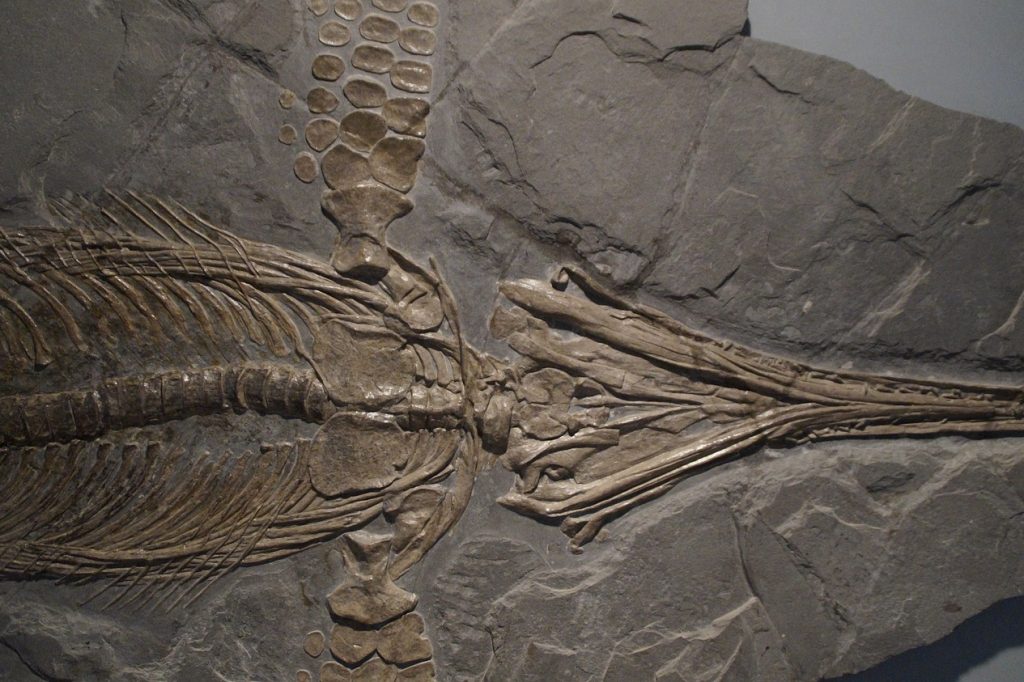Ichthyosaurus, which means “fish lizard” in Greek, is an extinct marine reptile that lived during the Mesozoic Era, particularly during the Early Jurassic to Late Cretaceous periods, about 250 to 90 million years ago. It was a fascinating creature with a streamlined, fish-like body and a unique evolutionary adaptation for an aquatic lifestyle. Despite its name suggesting a lizard-like creature, Ichthyosaurus was not a true dinosaur but rather a distant relative of modern reptiles.
These marine reptiles had a sleek, dolphin-like body, well-suited for efficient movement through water. Their limbs evolved into paddle-like structures, enabling them to navigate and propel themselves effectively in the ocean. Ichthyosaurus had a pointed snout, sharp teeth, and large eyes, indicating its carnivorous diet, likely consisting of fish and other marine organisms.
Ichthyosaurus fossils have been discovered primarily in Europe, particularly in the United Kingdom and Germany. Their abundance in the fossil record and the diversity of species suggest that Ichthyosaurus was a successful and widespread predator during its time, adapting well to the marine environment. Fossils have provided valuable insights into the anatomy, behavior, and evolution of this intriguing prehistoric marine reptile, contributing to our understanding of the ancient seas and the creatures that inhabited them.

Ichthyosaurs fossil
Let’s take a look at these 25 interesting facts about Ichthyosaurus to know more about this ancient reptile.
- Ancient Marine Reptile: Ichthyosaurus was an ancient marine reptile that lived during the Mesozoic Era, from the Early Jurassic to the Late Cretaceous period.
- Fish-Like Appearance: The name “Ichthyosaurus” is derived from Greek, meaning “fish lizard,” due to its fish-like appearance.
- Streamlined Body: Ichthyosaurus had a streamlined body resembling that of modern dolphins, making it well-suited for efficient swimming and hunting in the ocean.
- Lived Worldwide: Fossils of Ichthyosaurus have been found in various parts of the world, including Europe, North America, and Asia.
- Size Variations: Ichthyosaurus species varied in size, with some individuals measuring around 3 to 10 meters (10 to 33 feet) in length.
- Distinctive Eyes: Ichthyosaurus had large eyes, indicating acute vision that likely helped it in locating prey and navigating underwater.
- Sharp Teeth: They possessed sharp teeth well-suited for catching and consuming their prey, mainly fish and other marine organisms.
- Numerous Species: Over 20 different species of Ichthyosaurus have been identified based on fossil evidence, showcasing a diverse group of ancient marine reptiles.
- Fossil Discoveries: The first Ichthyosaurus fossil was described by British fossil hunter Mary Anning in the early 19th century, bringing significant attention to this prehistoric creature.
- Distinctive Fin Structure: Ichthyosaurus had a unique dorsal fin, which helped with stability and navigation in the water.
- Paddle-Like Limbs: The forelimbs and hindlimbs of Ichthyosaurus evolved into paddle-like structures, aiding in efficient swimming.
- Live Birth: Ichthyosaurus is believed to have given birth to live young, indicating viviparity, a rare trait among reptiles.
- Marine Habitat: These marine reptiles were well-adapted to a fully aquatic lifestyle and were unable to come onto land.
- Lived in Ancient Seas: Ichthyosaurus inhabited the ancient seas that covered what is now modern-day Europe, particularly regions like the United Kingdom.
- Geologic Time Range: The Ichthyosaurus genus lived approximately 150 million years ago during the Mesozoic Era.
- Soft Tissues Preservation: Some exceptionally preserved Ichthyosaurus fossils have provided insights into the soft tissues and skin impressions of these marine reptiles.
- Significant Bone Structure: Their bones were lightweight, featuring numerous tiny air pockets, which facilitated buoyancy control and helped them remain submerged.
- Extinct for Millions of Years: Ichthyosaurus became extinct around 90 million years ago, near the end of the Mesozoic Era.
- Influence on Victorian Era Science: The discovery and study of Ichthyosaurus fossils significantly influenced Victorian-era paleontology and the understanding of ancient life.
- Hydrodynamic Efficiency: Ichthyosaurus had a body design that allowed for hydrodynamic efficiency, minimizing drag while swimming in the ocean.
- Hunting Strategy: It’s believed that Ichthyosaurus hunted its prey by chasing and capturing them with its sharp teeth, similar to how modern dolphins hunt.
- Migratory Behavior: Some researchers propose that Ichthyosaurus exhibited migratory behavior, moving to warmer waters for breeding or to follow their prey.
- Fossil Record Abundance: The abundance of Ichthyosaurus fossils in some regions has contributed significantly to our understanding of marine life during the Mesozoic Era.
- Linked with Other Reptiles: Ichthyosaurus is closely related to other marine reptiles like Plesiosaurs and Mosasaurs.
- Educational Importance: Ichthyosaurus remains an essential subject of study in paleontology, providing valuable insights into the evolution and adaptation of marine life in Earth’s history.
Ichthyosaurus remains a captivating enigma of ancient marine life, offering us a glimpse into a distant past when oceans teemed with these fish-like reptiles. Their streamlined bodies, reminiscent of today’s dolphins, showcase the remarkable adaptations that evolution has crafted to thrive in diverse environments. The plethora of fossils unearthed and the ongoing research continue to unveil not only the physical characteristics but also the behaviors and ecological roles of Ichthyosaurus, enriching our understanding of prehistoric oceans and the intricate web of life that once inhabited them.





